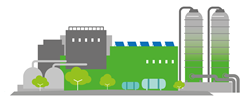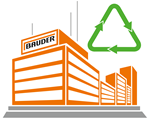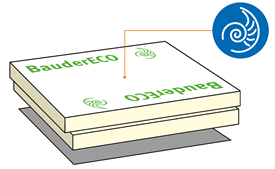What is Biomass Balance?
Here at Bauder, we are well known for our sustainable flat roof solutions that incorporate green roofs, blue roofs, and photovoltaics. With BauderECO FF we are making progress at product level through adopting the biomass balance approach to its manufacture.
Sustainable production means that the economic processes behind it are sensible and negative effects on the environment are minimised. At the same time, energy and natural resources should be protected. This requires that we, at Bauder, adopt new ways of thinking and innovative approaches. For example, we are using the biomass balance approach to introduce renewable raw materials into our ECO FF insulation product and migrate our products away from fossil sources without compromising product performance.
The biomass balance approach is a chain of custody model used to track the total amount of renewable plant-based raw material content through a manufacturing process/supply chain while ensuring an appropriate allocation of this content to the finished product. It allows for the mixing of sustainably sourced materials with non-sustainable materials.
This approach allows manufacturers, such as Bauder, to allocate alternative bio-based raw materials into existing, complex production pathways at speed and with limited requirement for additional or modified plant and equipment.
Benefits of biomass balance
■ Drives the use of renewable resources.
■ Saves fossil reserves.
■ Reduces greenhouse gas emissions.
■ Products have identical technical characteristics
In the production of our BauderECO FF PIR insulation, we source approximately 80% of our feedstock from processed renewable biomass replacing those derivatives obtained from fossil source giving a reduction of embodied CO2 and preserving fossil resources. The biomass balanced raw materials are combined with recycled milling and sawing dust from PIR, coupled with other raw materials to form the insulating core of BauderECO FF. This process and the volume of biomass inputs, and our outputs, are independently verified and certified in accordance with the REDcert² standard.
Under the biomass balance model, the resulting product may not contain quoted volumes of biomass based raw material. However, the volumes of biomass based raw material are allocated and verified by a 3rd party certification scheme.
Fundamentally, because the raw ingredient chemicals are the same, the quality and performance of our ECO FF PIR insulation matches our established PIR rigid boards. However, this does not mean that we are assuming the performance is the same. We are testing the performance of our ECO FF product within our waterproofing systems to confirm the functional and operational qualities meet those required by the construction industry for thermal, fire and wind uplift. Once testing is successful the performance attributes of ECO FF will be added to our BBA certificate for verification of all of our PIR insulation.
1. Fossil raw materials.

2. Renewable raw materials that are produced from biomass - e.g. from agricultural residues.
 3.
3. At the beginning of the production process, both compontents are mixed by our suppliers.
 4.
4. The proportion of biomass is mathematically allocated to the
biomass-balanced raw material. This process is tested and certified in accordance with the REDcert
2 standard.
 5.
5. The raw materials are supplied with a certificate confirming the allocated biomass content.

 6.
6. The biomass-balanced raw materials are combined with
recycled milling and sawing dust and other raw materials to form the insulating core of BauderECO FF.
 7.
7. The insulation boards are given a facing that includes
lime from shells in conjunction with a glass fleece.